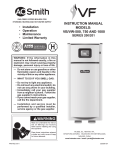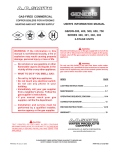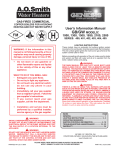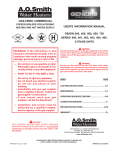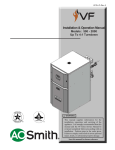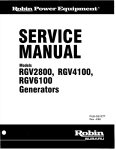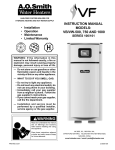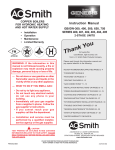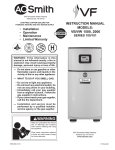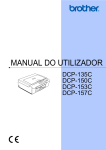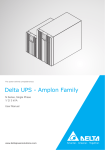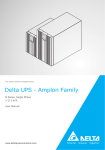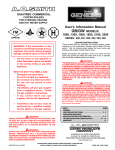Download A.O. Smith 101 User's Manual
Transcript
GAS-FIRED POWER BURNER COPPER BOILERS FOR HYDRONIC HEATING AND HOT WATER SUPPLY • • • • USER’S MANUAL MODELS: VB/VW-500, 750 AND 1000 Installation Operation Maintenance Limited Warranty SERIES 100/101 WARNING: If the information in this manual is not followed exactly, a fire or explosion may result causing property damage, personal injury or loss of life. — Do not store or use gasoline or other flammable vapors and liquids in the vicinity of this or any other appliance. — WHAT TO DO IF YOU SMELL GAS: • Do not try to light any appliance. • Do not touch any electrical switch; do not use any phone in your building. • Immediately call your gas supplier from a neighbor’s phone. Follow the gas supplier’s instructions. • If you cannot reach your gas supplier, call the fire department. — Installation and service must be performed by a qualified installer, service agency or the gas supplier. MC BEE, SC., RENTON, WA., STRATFORD-ONTARIO, VELDHOVEN-THE NETHERLANDS, NANJING, CHINA www.hotwater.com / email: [email protected] PRINTED 0207 212801-000 1 SAFE INSTALLATION, USE AND SERVICE Your safety and the safety of others is extremely important in the installation, use, and servicing of this boiler. Many safety-related messages and instructions have been provided in this manual and on your own boiler to warn you and others of a potential injury hazard. Read and obey all safety messages and instructions throughout this manual. It is very important that the meaning of each safety message is understood by you and others who install, use, or service this boiler. All safety messages will generally tell you about the type of hazard, what can happen if you do not follow the safety message and how to avoid the risk of injury. IMPORTANT DEFINITIONS • Qualified Installer: A qualified installer must have ability equivalent to a licensed tradesman in the fields of plumbing, air supply, venting and gas supply, including a thorough understanding of the requirements of the National Fuel Gas Code as it relates to the installation of gas fired boilers. The qualified installer must have a thorough understanding of this instruction manual. • Service Agency: A service agency also must have ability equivalent to a licensed tradesman in the fields of plumbing, air supply, venting and gas supply, including a thorough understanding of the requirements of the National Fuel Gas Code as it relates to the installation of gas fired boilers. The service agency must also have a thorough understanding of this instruction manual, and be able to perform repairs strictly in accordance with the service guidelines provided by the manufacturer. • Gas Supplier: The Natural Gas or Propane Utility or service who supplies gas for utilization by the gas burning appliances within this application. The gas supplier typically has responsibility for the inspection and code approval of gas piping up to and including the Natural Gas meter or Propane storage tank of a building. Many gas suppliers also offer service and inspection of appliances within the building. 2 GENERAL SAFETY 3 CONTENTS SAFE INSTALLATION, USE, AND SERVICE ....................................................................................................................................... 2 GENERAL SAFETY ................................................................................................................................................................................ 3 TABLE OF CONTENTS ......................................................................................................................................................................... 4 Installation Requirements for the Commonwealth of Mass ................................................................................................................... 5 Wiring Diagram .................................................................................................................................................................................... 6-7 Schematic Diagram ................................................................................................................................................................................ 8 Lighting and Operating Instructions ....................................................................................................................................................... 9 Water Temperature Regulation ............................................................................................................................................................ 10 Control System ................................................................................................................................................................................ 10-11 Operating Sequence ............................................................................................................................................................................. 11 UIM Operating Procedures .................................................................................................................................................................. 12 Operating Setpoint Adjustment Procedure .......................................................................................................................................... 14 TROUBLESHOOTING IGNITION SYSTEM ......................................................................................................................................... 16 Troubleshooting Gas Valve .............................................................................................................................................................. 17 PREVENTATIVE MAINTENANCE ........................................................................................................................................................ 17 Main Burners .................................................................................................................................................................................... 17 Relief Valve ...................................................................................................................................................................................... 18 Combustion Air Filter ....................................................................................................................................................................... 18 Blower Compartment ........................................................................................................................................................................ 18 Burner Maintenance ......................................................................................................................................................................... 18 Condensate Removal System ......................................................................................................................................................... 18 Venting Maintenance ........................................................................................................................................................................ 19 Heat Exchanger Preventive Maintenance ....................................................................................................................................... 19 Tube Cleaning Procedure ................................................................................................................................................................ 19 REPLACEMENT PARTS ...................................................................................................................................................................... 19 LIMITED WARRANTY .......................................................................................................................................................................... 23 INTRODUCTION This design complies with the current edition of the ANSI Z21.13 low-pressure boiler standard. AL 29-4C® is a registered trademark of Allegheny Ludlum Corporation. Compliance under this standard implies that when the boiler underwent test, the gas manifold and control assembly provided on the boiler met safe lighting and other performance criteria. In addition to these instructions, the boiler(s) shall be installed in accordance with those installation regulations in force in the local area where the installation is to be made. These shall be carefully followed in all cases. Authorities having jurisdiction should be consulted before installations are made. Detailed installation diagrams are found in this manual. These diagrams will serve to provide the installer a reference for the materials and methods of piping necessary. It is essential that all water, gas piping and wiring be installed as shown on the diagrams. You should thoroughly read and understand this manual before installation and/or operation of this boiler. In the absence of local codes, the installation must comply with the current editions, as follows: In the United States: The National Fuel Gas Code, ANSI Z223.1/NFPA 54 and the National Electric Code, NFPA 70. The factory warranty will be void if the boiler(s) have been improperly installed or operated. 4 INSTALLATION REQUIREMENTS FOR THE COMMONWEALTH OF MASSACHUSETTS For all side wall terminated, horizontally vented power vent, direct vent, and power direct vent gas fueled water heaters installed in every dwelling, building or structure used in whole or in part for residential purposes, including those owned or operated by the Commonwealth and where the side wall exhaust vent termination is less than seven (7) feet above finished grade in the area of the venting, including but not limited to decks and porches, the following requirements shall be satisfied: INSTALLATION OF CARBON MONOXIDE DETECTORS At the time of installation of the side wall horizontal vented gas fueled equipment, the installing plumber or gasfitter shall observe that a hard wired carbon monoxide detector with an alarm and battery backup is installed on the floor level where the gas equipment is to be installed. In addition, the installing plumber or gasfitter shall observe that a battery operated or hard wired carbon monoxide detector with an alarm is installed on each additional level of the dwelling, building or structure served by the sidewall horizontal vented gas fueled equipment. It shall be the responsibility of the property owner to secure the services of qualified licensed professionals for the installation of hard wired carbon monoxide detectors. In the event that the side wall horizontally vented gas fueled equipment is installed in a crawl space or an attic, the hard wired carbon monoxide detector with alarm and battery back-up may be installed on the next adjacent floor level. In the event that the requirements of this subdivision can not be met at the time of completion of installation, the owner shall have a period of thirty (30) days to comply with the above requirements provided that during said thirty (30) day period, a battery operated carbon monoxide detector with an alarm shall be installed. APPROVED CARBON MONOXIDE DETECTORS Each carbon monoxide detector as required in accordance with the above provisions shall comply with NFPA 720 and be ANSI/UL 2034 listed and CSA certified. SIGNAGE A metal or plastic identification plate shall be permanently mounted to the exterior of the building at a minimum height of eight (8) feet above grade directly in line with the exhaust vent terminal for the horizontally vented gas fueled heating appliance or equipment. The sign shall read, in print size no less than one-half (1/2) inch in size, “GAS VENT DIRECTLY BELOW. KEEP CLEAR OF ALL OBSTRUCTIONS.” INSPECTION The state or local gas inspector of the side wall horizontally vented gas fueled equipment shall not approve the installation unless, upon inspection, the inspector observes carbon monoxide detectors and signage installed in accordance with the provisions of 248 CMR 5.08(2)(a) 1 through 4. EXEMPTIONS: The following equipment is exempt from 248 CMR 5.08(2)(a)1 through 4: 1. The equipment listed in Chapter 10 entitled “Equipment Not Required To Be Vented” in the most current edition of NFPA 54 as adopted by the Board; and 2. Product Approved side wall horizontally vented gas fueled equipment installed in a room or structure separate from the dwelling, building, or structure used in whole or in part for residential purposes. MANUFACTURER REQUIREMENTS - GAS EQUIPMENT VENTING SYSTEM PROVIDED When the manufacturer of Product Approved side wall horizontally vented gas equipment provides a venting system design or venting system components with the equipment, the instructions provided by the manufacturer for installation of the equipment and the venting system shall include: 1. Detailed instructions for the installation of the venting system design or the venting system components; and 2. A complete parts list for the venting system design or venting system. MANUFACTURER REQUIREMENTS - GAS EQUIPMENT VENTING SYSTEM NOT PROVIDED When the manufacturer of a Product Approved side wall horizontally vented gas fueled equipment does not provide the parts for venting the flue gases, but identifies “special venting systems,” the following requirements shall be satisfied by the manufacturer: 1. The referenced “special venting system” instructions shall be included with the appliance or equipment installation instructions; and 2. The “special venting systems” shall be Product Approved by the Board, and the instructions for that system shall include a parts list and detailed installation instructions. A copy of all installation instructions for all Product Approved side wall horizontally vented gas fueled equipment, all venting instructions, all parts lists for venting instructions, and/or all venting design instructions shall remain with the appliance or equipment at the completion of the installation. 5 6 CONNECTION DIAGRAM 7 VB/VW-500, 750 & 1000 SCHEMATIC DIAGRAM SCHEMATIC DIAGRAM 8 LIGHTING & OPERATION INSTRUCTIONS FOR MODELS VB/VW 500, 750 AND 1000: 9 children to use a hot water tap, or to draw their own bath water. Never leave a child or disabled person unattended in a bathtub or shower. The boiler should be located in an area that is inaccessible to the general public. TABLE 1. Risk of Scalds. Temperature Setting Over 170°F (77°C) 160°F (71°C) 150°F (66°C) 140°F (60°C) 130°F (54°C) 120°F (49°C) or less WATER TEMPERATURE REGULATION Time to Produce 2nd & 3rd Degree Burns on Adult Skin Nearly instantaneous About 1/2 second About 1-1/2 seconds Less than 5 seconds About 30 seconds More than 5 minutes SHOULD OVERHEATING OCCUR OR THE GAS SUPPLY FAIL TO SHUT OFF, TURN OFF THE MAIN MANUAL GAS SHUTOFF VALVE TO THE APPLIANCE. The operating temperature of the boiler must be maintained as follows: • 120°F (49°C) or higher inlet water temperature to the boiler. • 20°F (11°C) differential between the boiler’s inlet and outlet (e.g. 120°F [49°C] inlet, 140°F [60°C] outlet minimum design temperatures). If the inlet water temperature into the boiler is less than 120°F (49°C), adjustments on the water bypass are needed. Please contact your A.O. Smith qualified service agent. CONTROL SYSTEM HOT WATER CAN SCALD: Boilers are intended to produce hot water. Water heated to a temperature which will satisfy space heating, clothes washing, dish washing and other sanitizing needs can scald and permanently injure you upon contact. Some people are more likely to be permanently injured by hot water than others. These include the elderly, children, the infirm or physically/ mentally disabled. If anyone using hot water in your home fits into one of theses groups or if there is a local code or state law requiring a specific temperature water at the hot water tap, then you must take special precautions. In addition to using the lowest possible temperature setting that satisfies your hot water needs, a means such as a mixing valve shall be used at the hot water taps used by these people or at the hot water supply tank. Mixing valves are available at plumbing supply or hardware stores. Follow the manufacturer’s instructions for installation of the valves. Before changing the thermostat setting on the hot water system controller, see Table 1. The EMC modulation control system is a fully integrated, state of the art electronic control system. It consists of sensors, output devices, a power switch, a 24VAC transformer, wiring, and the following printed circuit boards: • Modulation Control Board (MCB) • Power Distribution Board (PDB) • User Interface Module (UIM) The MCB contains circuitry for both master control and flame control. Dip switches on the MCB are used to configure the system. The User Interface Module (UIM) communicates with the user through a set of touch pads and a 4-line, 20-character LCD display. The PDB provides connection points for input power, the water pump, and the transformer. It also distributes power to the system and contains the system fuses. The MCB also contains an external communications system to allow for connection to a PC, a modem, an EMS system, or something similar. Through this connection, multiple boilers can also be linked together. CAUTION: The internal communications cables should never be connected to the external communications connectors, and vice-versa. Hot water temperatures required for automatic dishwasher and laundry use can cause scald burns resulting in serious personal injury and/or death. The temperature at which injury occurs varies with the person's age and time of exposure. The slower response time of children, aged or disabled persons increases the hazards to them. Never allow small There are several microcontrollers used on the boards. These control the temperature and ignition control functions for the boiler. Inherent in the design are the normal operating 10 Pump (MCB - 120VAC - required on systems that do not have an external pump): Provides electrical power to directly operate a pump or the coil of an externally connected contactor. sequences and safety features associated with a gas ignition control system. The system continuously performs various diagnostic tests to verify proper appliance and control operation. Should an unsafe condition occur, the control will shut down the burner and display a red service light as well as indicate the cause of the error on the display. The operating programs for the system are stored in permanent memory inside the microcontrollers. User-selectable operating parameters and a history of detected faults are stored in rewritable memory in the microcontrollers. A loss of power does not affect either of the memories. Blower (MCB - 120VAC - required): Variable speed blowers utilize the high blower output only. Igniter (MCB - 120VAC - required): Provides power to operate the HSI igniters. Gas Valve (MCB - 24VAC - required): Provides power to activate the gas valve. The gas valve cannot be activated when the ECO contacts are open. INPUTS TO MCB Low Water Cut Off (MCB - 24VAC - optional): Directly connected to the 24VAC line to provide power to operate an external LWCO device. TEMPERATURE SENSORS: Temperature probes (MCB - outlet and either inlet or tank are required): The MCB accepts analog temperature inputs from up to three sensors (inlet, outlet, and remote). MCB AND PDB INDICATOR LAMPS AND FUSES A green LED is mounted on the PDB to indicate when line voltage is applied (the PDB also contains a yellow and red LED, and a test/run jumper that are used during installation to verify proper power connections). A red LED on the MCB is used to indicate when the 24VAC input fuse has blown. ECO input (MCB - required): The ECO (energy cut off) is a hilimit switch located inside the outlet probe. It is a normally closed switch that opens if the probe is exposed to a temperature higher than the trip point. Once tripped, the control system needs to be manually reset. Yellow LEDs are located near the microcontrollers on the MCB. These LEDs are “heartbeat indicators,” and blink approximately twice per second to indicate that the microcontrollers are running. Thermostat input (MCB - optional): This input is set up to work with an externally connected thermostat that provides a contact closure. If this input is closed and everything else is in the proper state, a “call for heat” condition will be initiated. These leads should be shorted together when a thermostat is not being used. If it is desired that the thermostat control the temperature of the boiler, the operating setpoint of the system should be set higher than the temperature that the thermostat is controlling. This will allow the thermostat to control the boiler. When the thermostat closes, a call for heat will be generated until the thermostat determines that the required temperature has been reached. MCB JUMPERS The MCB has two jumpers. JP1 on the MCB is used to terminate the external communications line. It is normally left off and installed when the external cable is very long. IGNITERS The EMC modulation system operates with Silicon Carbide Igniters. AIR PRESSURE SENSORS (OPEN CONDITION INDICATES FAULT): Blocked Flue (MCB - required): Normally closed switch that opens if the flue becomes blocked during operation. OPERATING SEQUENCE Blower Prover (MCB - required): Normally open switch that closes when the air pressure produced by the blower is above the set point. GAS PRESSURE SENSORS (OPEN CONDITION INDICATES FAULT): Low Gas (MCB - required): Normally closed switch that opens when the gas pressure falls below the trip level. This input is enabled/disabled by a dip switch on the MCB 1. The EMC modulation controller has four modes of operation: Initialization, Standby, Running/Modulation, and Service. The internal MCB micros control these modes through a sequence of steps (or States) which are further described in the "UIM Operating Procedures" section. 2. When power is applied to the system, it enters the initialization mode and the following automatic functions are performed: • A. O. Smith opening screen is displayed. • The system goes through a calibration indicated by the green running LED blinking and then staying on; next the red service LED and yellow standby LEDs come on, next the service and runnings LEDs blink ON and OFF. • Stored values are recalled from memory. • Configuration dipswitches are read. • Pending faults are recalled • Micros on all boards start running (indicated by a flashing Yellow LED near each micro) • Input sensors are read 3. After initialization is complete (approximately 10 seconds) the system turns the green LED off and goes to the standby mode (yellow "Standby" LED on), unless a previously stored fault has been recalled, which will send the system into the service model (red "Service" LED on). In standby mode the display shows the temperature screen and in fault mode the current error screen is displayed. 4. The system then compares the temperature read from the controlling probe (inlet or tank) to the setpoint temperature. If Hi Gas (MCB - required): Normally closed switch that opens if the gas pressure exceeds a set value. This input is enabled/disabled by a dip switch on the MCB. WATER LEVEL SENSOR (OPEN CONDITION INDICATES FAULT): Low Water Cut Off (MCB - optional): Normally open switch that closes when water reaches preset level. This input is enabled/ disabled by a dip switch on the MCB. WATER FLOW SENSOR: Flow (MCB - required): Normally open switch that closes when flow exceeds a set value. FLAME SENSOR: Flame (MCB - required): Returns a signal to the microprocessor if flame is detected on the burner. If the flame rod is missing or shorted, the flame will not be detected. OUTPUTS FROM MCB RELAY CONTACT OUTPUT: Alarm (MCB - 24VAC - optional): Provides electrical power to operate an external alarm. This can be an audio device (i.e., Sonalert), a visual device (lamp), or any other device that will operate with the voltage and current level provided. 11 the temperature is less than the operating setpoint minus the differential temperature and the thermostat input is closed then a call for heat is established and the system shifts to the run mode (green "Running" LED turns on). 5. The heating sequence begins by applying power to the pump. 6. After a few seconds the blower is turned on for 30-second pre-purge period of combustion chamber. 7. The igniter is turned on. 8. After the igniter has reached a minimum of 2.8 amps, the gas valve is energized to allow gas flow to burner. 9. After an additional one second, the system checks the status of the flame through the flame rod (sensor). If the flame is not verified within 4 seconds, the gas valve is immediately shut off followed by 15-second inter-purge period, then the system returns to step 7, if the "Trial for Ignition" dipswitch is set for three (3) tries. If the dipswitch is set for one (1) trial, the system will declare an error and boiler will require resetting the control. The UIM receives commands from the user and displays operational information to the user via an LCD (liquid crystal display) up to eleven LED's, and five touch switches. The LCD provides information to the user by the use of 10 menu-activated screens. Within each of the screens, helpful information can be displayed by pressing the "Help" button. The LED's visually inform the user about the mode the system is in. The touch switches allow the user to control the operation of the system. The operation of these parts is described in the following section: UIM Screens: On all screens a double vertical bar appears on the right side of the display each time a key is touched to indicate that a key has been activated. On several screens an indicator ">" appears on the left side of the display to indicate the active line. The "Up/ Down" keys are used to move the indicator to the desired line and the "Select" key is pressed to select the line. Also, on most of the screens, up/down arrows appear on the right side of the screen to indicate that there is additional lines either above or below the displayed four lines. • Menu Screen: Displayed when the user presses the "Menu" key. This screen is the selection point for the other 9 screens. 10. The boiler will remain running until the set point is satisfied. Once satisfied, the blower will continue for 15-second post purge period. • Temperature Screen: Displays the sensed temperatures of the Outlet, Inlet, and Tank probes. Also displayed is the calculated Delta T (Outlet minus Inlet) for the system. Shorted ("Short") and disconnected ("----") probes are also displayed. 11. Once set point has have been satisfied, the boiler pump will continue to run for the programmed post-circulate cycle. 12. The control now enters the idle state as displayed by the "Standby" LED. The control will continue to monitor heat demand and state of other system devices. Upon a drop of water temperature below the set parameters, the control will return to step 5 and repeat the entire operating cycle. Note: Any fault detection, during standby or running modes, will halt the heating sequence and shift the system to the service mode where the detected fault will be displayed. • System Status Screen: This screen is used to view the status of switch inputs and output states. An asterisk (*) is displayed next to the label when the status is "True" (the description is fulfilled). For example, if water is flowing, or detected by the flow sensor, then an "*" will appear in front of the Flow label (i.e. *Flow). Another example would be the ECO switch. If the outlet temperature is too high the display will show: *ECO. NOTE: In standby and running modes the system constantly monitors the signals and the internal operation for faults. Any detected fault will halt the heating sequence and shift the system to the service mode, where the detected fault will be displayed. The System monitors the inputs at these times: TEMPERATURE SETPOINTS (SYSTEM CONTROL ALGORITHM) • ECO, Blocked Flue, Low Gas, Hi Limit, and Hi Gas - at all times for a fault condition. • Tstat - at all times for open/closed conditions. • Flow - for an on condition when the pump is on (no check for off state) • Blower Prover - when the Blower is on. • Igniter Current - for an on condition approximately 18 seconds after the Igniter is turned on until the igniter is turned off and an off condition at all other times. • Flame - for an on condition approximately 5 seconds after the gas valve is turned on until the valve is turned off and at all other times for an off condition. The boiler has a hysteresis type control, which means that it will begin heating the water when the temperature sensed by the control probe (inlet or tank) falls below the operating setpoint minus the differential setpoint. It will stop heating the water when the temperature rises to the operating setpoint. UIM OPERATING PROCEDURES Control Status Screen: Displays the status that the MCB micros are in. The MCB has 5 possible states and the FCB have 9. The normal MCB states sequence is to move from Idle to Pre-Circulate when a call for heat is initiated. Once heat has been satisfied or the Thermostat is opened, the sequence moves to Post-Circulate and then back to Idle. If a fault occurs at any time, the process jumps out of sequence and goes directly to the appropriate Hard or Soft Fault state. Description of MCB control states: • Idle: The yellow "Standby" LED is turned on and the system UIM, USER INTERFACE MODULE 12 waits for a heat request (determined by the Thermostat or controlling probe inputs). All outputs are off in this state except that if the Post-Circulate time is set to continuous, the pump will be on. When the heat request is received, the system moves to the Pre-Circulate state. • • • will remain in this state until the MCB request a heating cycle, or a cold purge. Pre-Circulate: The yellow LED is turned off and the green "Running" LED is turned on. The green LED will remain on for all other states except the fault states. Cold purging clears out any combustion gas that may be in the combustion chamber. When purging is complete the system moves to the Heat State. Heat Stage The system will command the FCB micros to start their heat sequence. will be activated in order based on an algorithm that determines how much heat is needed. The system will remain in this state until the heat request is satisfied, the Tstat is opened, or a fault occurs. • Pre-Purge State: The blower is turned on. After 10 to 34 seconds (34 seconds for cold purging) the system switches to the Heat Igniter State. • Heat Igniter State: The sequence of operation is as follows: "The igniter relay is energized and the heat up period begins. After 18-20 seconds, if the igniter has reached a minimum of 2.8 amps, the gas valve safety circuit is then activated. If in this amount of time, the igniter fails to reach a minimum amp draw of 2.8 amps, the unit will re-cycle up to 3 times before locking out on igniter hardware failure. If the igniter does reach the minimum required amp draw of 2.8 amps, the gas valve circuit is energized, and the system advances to Flame Check status. • Check for Flame State: The gas valve is turned on. After 1.5 seconds, the system checks that the gas valve relay is on. If it is not, the ignition trial is considered to have failed and the system advances to the Inter-Purge state, if any ignition trials remain, otherwise an error is declared. Soft Fault State: (See "Fault Description" section for list of soft and Auto Reset faults.) The pump remains on for the selected post-circulate time to cycle the hot water out of the boiler. The FCB is commanded to shut down and the Alarm output is turned on. The green LED turns off and the red "Service" turns on. The MCB remains in this state until one of the following occurs: The flame sensor is checked. If flame is detected, the igniter is turned off. The state machine then advances to the Heating State. If after 5 seconds, the flame is still not sensed then the ignition trial is considered to have failed. The state machine advances to Inter-Purge if any ignition trials remain, otherwise an error is declared. • One hour passes (automatic restart after one hour) • If Communications error system will automatically restart if communications re-establishes. • If user presses Select key while current error screen is displayed (Hard reset). • If high-limit error - the outlet temperature drops below the high limit trip point minus the high limit differential. (outlet water temperature drops to safe level). The fault is logged in the error history when the fault state is exited. • Hard Fault State: (See "Fault Description" section for list of soft and Auto Reset faults.) The pump remains on for the selected post-circulate time to cycle the hot water out of the boiler. The FCB is commanded to shut down and the Alarm output is turned on. The green LED turns off and the red "Service" turns on and off (flashes). The only way to exit this state is for the user to press the Select key while the current error screen is displayed. The fault is logged in the error history when the fault state is exited. While the MCB is in the Heating mode the FCB moves from Idle, to Pre-Purge, to Heat Igniter, to Check for Flame, and then to Heating. The process waits in this state until the call for heat is satisfied, the thermostat input is opened, or a fault occurs. When heat is satisfied, the sequence continues to Post-Purge and then back to Idle. If three tries for ignition has been selected on the MCB dipswitch and flame is not detected at the appropriate time, then the sequence moves to the Inter-Purge state for 15 seconds and the FCB heat sequence is repeated. If flame is still not detected after the third try the process declares a fault, jumps out of sequence and goes to the error state. Other types of faults detected at any time will also cause a jump to the error state. Description of FCB control states: • Idle State: When any error is declared during idle state-The system 13 • Heating State: The system remains in this state until the call for heat is cancelled or a fault occurs. The system returns to the Idle state if the call for heat is cancelled, or satisfied and to the appropriate fault state if a fault occurs. • Inter-Purge State: The gas valve and the igniter are turned off. The blower is on. After approximately 15 seconds the system goes back to the Heating Igniter State. • Post-Purge State The gas valve and the igniter are turned off. The blower is then left on for approximately 25 seconds, the system returns to the Idle state. • Error State The gas valve and the igniter are turned off. The FCB micro tells the MCB micro which error has occurred. The system waits in this state until the MCB sends a command to clear the error, and the system returns to the idle state. • Cold Purge State Cold purge occurs when the MCB micro commands the blower to go on before lighting to clear the unit of residual gases. This state normally lasts approximately 32 seconds but on a • • if the blower prover does not activate after 15 seconds. This time allows the blower relay to activate, the blower to come up to speed, and the response from the blower prover to be filtered. 5. Press the SELECT KEY. User Settings Screen: Each setpoint or user setting has either a limited selection of values, or a limited range of values. The Up/Down keys are used to change values. After changing an item, the Select key is pressed to accept the change, or the Menu key is pressed to reject the change and restore the item to its original value. The following setpoints can be changed: 7. Press the SELECT key to accept and store the new value. 6. Use the UP and DOWN key to select the value you wish to enter. • High Limit Differential: The outlet temperature must be below the automatic High Limit setpoint minus the High Limit Differential setpoint before a call for heat can be generated. HIGH LIMIT DIFFERENTIAL SETPOINT ADJUSTMENT PROCEDURE Operating Setpoint: This setpoint sets the base temperature for the control algorithm. The High Limit Differential Setpoint has a range of 1°F to 50°F for all models. Use the following procedure to change the High Limit Differential Setpoint: 1. Press the MENU key. OPERATING SETPOINT ADJUSTMENT PROCEDURE The system has a standard programmable Operating Setpoint range of 70°F (21°C) to 190°F (88°C) for a VW and of 70°F (21°C) to 220°F (104°C) for a VB for either a Remote or inlet probe depending on selection. The user can easily change the Operating Setpoint at any time by using the following procedure. When any configuration or setpoint is changed (and the Select key touched), the new value is IMMEDIATELY saved to non-volatile memory. The factory default setting is 145°F (49°C). 2. Scroll the ">" with the down key next to USER SETTING SCREEN. 3. Press the SELECT key. 4. Scroll the ">" with the DOWN key until it is pointing to HIGH LIMIT DIFFERENTIAL SETPOINT. 5. Press the SELECT key. 1. Press the MENU key. 6. Use the UP or DOWN key to select the value you wish to enter. 2. Scroll the ">" with the DOWN key next to the USER SETTING SCREEN. 7. Press the SELECT key to accept and store the new value. 3. Press the SELECT key. • Operating Differential Setpoints: Each of the two stages has an independent Operating Differential setpoint. • Temperature Units: Temperature can be displayed in either °F or °C units. • Post Circulate Delay Time: The time circulation pump will stay on after the burner is turned off. The time in seconds is adjustable with the following values: 45, 90, 180 or continuous. If the continuous value is selected the pump will remain on at all times and the post circulate state time will be set at 45 seconds. • Network Address: This is a unique number assigned to this boiler to differentiate it from other boilers or water heater on the same A. O. Smith proprietary network. A valid Network Address can be any number from 0 to 31. It is set by default to zero, which is an invalid address. The boiler will not communicate until it is changed to a valid and unique number. This prevents two units from trying to respond to the same request from the PC or supervisory network device. • Configuration Settings Screen: Displays the status of the dipswitches installed on all boards as described earlier. • 3. Press the SELECT key. Log & System Info Screen: Displays the following information: Elapsed hours of operation (Total time system has been powered up) 4. Scroll the ">" with the DOWN key until it is pointing to HIGH LIMIT SETPOINT. Number of running minutes (Number of minutes system has been in the run mode) 4. Scroll the ">" with the DOWN key until it is pointing to OPERATING SETPOINT. 5. Press the SELECT key. 6. Use the UP or DOWN key to select the value you wish to enter. 7. Press the SELECT key to accept and store the new value. • High Limit: The outlet temperature probe contains both an ECO switch and a thermistor for temperature measurement. The sensed outlet temperature is used for the automatically resettable High Limit setpoint. If the sensed outlet temperature exceeds the High Limit setpoint, a "soft lockout" condition will occur and the burner will be shut off. This fault condition is automatically cleared when the temperature drops below the high limit setpoint minus the high limit differential. AUTO HIGH LIMIT SETPOINT ADJUSTMENT PROCEDURE/ OUTLET TEMPERATURE PROBE The High Limit setpoint has a range of 90°F (32°C) to 210°F (99°C) for a VW and a range of 90°F (32°C) to 235°F (113°C) for a VB. Use the following procedure to change the automatically resettable High Limit Setpoint: 1. Press the MENU key. 2. Scroll the ">" with the DOWN key next to USER SETTING SCREEN. 14 From the Current Error Screen this key is used to reset the system from an error: kBtu rating of the boiler (0 to 5750kBtu in 10kBtu increments) The software revision level of the MCB. • • • Current Error Screen: Displays the last error that the system has detected plus a time stamp of when the error occurred. (The time stamp is based on the elapsed hours value at the time the error occurred. It is displayed in hours and minutes. This error remain displayed as long as it is still valid. When cleared it is moved to the Error History Screen. The system will automatically jump to this screen when an error is detected. It will also go to this screen upon power-up if an error was still valid when power was turned off. NOTE: Errors are cleared from this screen by pressing the "select" key. Error History Screen: This screen displays a list of the last 9 errors (with time stamps) that have occurred. The last error to occur is displayed first. Reload Defaults Screen: From this screen the user can restore the factory default values for screen adjustable configurations by pressing the Select key. The values restored are as follows: VW Models Oper Setpnt (Operating Setpoint) - 145° F (63° C) Hi Limit (High Limit Setpoint) = 210° F (99° C) Hi Limit Dif (High Limit Differential) = 20° F (11° C) Both Models Tempert Units (Temperature Units) = F Post Cir Secs (Post Circulation pump delay = 45 seconds Network Address (Network Address) = (none) • Select Key: This key performs several functions. Screens can be selected from the menu screen by pressing this key when the ">" appears next to the screen desired. • Help Key: Pressing the Help key from any screen displays helpful information about that screen. From the menu screen, general help information is displayed as to how to use the user interface. To return to the previous screen press the Help or Select keys, or press Menu key to go to the menu screen. If a small down arrow appears in the lower right hand corner then there is off screen content below what is displayed. Press the down arrow to scroll down to this information. After scrolling down an up arrow will appear in the upper right hand corner to indicate off screen content above what is displayed. The VF boiler has a display on the UIM which is a scaled display indicating the current firing rate of the boiler (25% to 100%). UIM Touch Switches Below the LCD display are five touch switches or keys, that the operator uses to operate the system. Menu Key: Pressing this key activates the menu screen where the other screens can be accessed. Up and Down Keys: These keys are used to move upwards and downwards in screens to reach a desired item and to change setpoints and user settings. They have an auto increment/decrement feature for some of the configurations and values. When you first press one of the keys and value changes by 1 count, then wait 1/2 second and changes slowly until the key is released or if held for 3 or more seconds it will change the value quickly. UIM LED's The three LED's to the right of the LCD indicate the status of the overall system. The red LED indicates that a fault has been detected and the system has stopped running. It is on continuously for soft faults and flashes for hard faults. The Yellow LED indicates that the boiler is in a ready mode waiting for a call for heat command. When on continuously the Green LED indicates that the system is in the heating mode. If it is flashing it indicates that the UIM is in the initialization mode and the touch switches are being calibrated. VB Models Oper Setpnt (Operating Setpoint) = 190° F (88° C) Hi Limit (High Limit Setpoint) = 230° F (110° C) Hi Limit Dif (High Limit Differential) = 20° F (11° C) • • Fault Messages and Troubleshooting Guide The EMC 5000 modulation system does excessive self-diagnostics and displays detected faults on the UIM display in an easy to read manner. There are approximately 80 different faults that can be detected. Some of the faults are caused by internal problems and some by external causes. The faults create different types of system lockouts (shut down). Hard lockouts are serious problems that require the user to manually restart the system. Soft lockouts can be reset by the user or after 60 minutes the system will automatically clear the error and restart. Auto Reset lockouts will monitor the cause of the fault and it the fault clears itself the system resets itself. The following table shows the fault messages and some possible troubleshooting hints: On the User Settings screen items that appear next to a ">" symbol can be selected with this key. If a setpoint configuration item is selected, the ">" will then flash slowly to indicate that the item has been selected. The Up and Down keys are then used to change its value. 15 TROUBLESHOOTING IGNITION SYSTEM Fault Messages and Lockout Status (* = stage number: 1, 2, 3, or 4) FAULT DISPLAYED DESCRIPTION RED LED LOCKOUT “Display Fail” Communications with UIM interrupted Continuous Auto Reset Check communication cable to UIM. Try moving to other Internal Communications connector on MCB. Also check the connectors where the cable is plugged in for best connecting wires. “Comm. Fail Stg.*” Communications with FCB interrupted Continuous Same as above. Also try swapping FCB and UIM communications cables. “Low AC Voltage” Line voltage less than 90 vac Continuous Auto Reset Check incoming power line for loss of voltage. May also be caused by a power line brown-out (momentary loss of voltage) “Low 24VAC” Voltage from transformer less than 18 vac Continuous Auto Reset Check transformer output. Should be over 24vac. May be caused by excessive current drain or a faulty transformer “Brown Out Reset” Indicates a brown out reset occurred ---None Caused by a momentary dip in voltage on the MCB +5vdc power bus. Contact factory. (Not considered a serious problem if it only occurs on very rare occasions.) “Timeout Reset” Indicates a watchdog reset occurred ---None Caused when the micro executes the software in an improper way. Contact factory. (Not considered a serious problem if it only occurs on very rare occasions.) “FCB Comm Timeout” FCB did not receive command from MCB Continuous SOFT Caused when communications between the MCB and the FCB are interrupted. May occur when a surge of power on a nearby device (i.e. arc welder) creates an EMI burst. Not a serious problem if it occurs rarely. “No Flow” Water is not flowing Continuous SOFT Caused by the flow switch being open when it should be closed. Check water lines, pump, flow switch contacts, wiring. “Blower Prov Stg* Blower pressure is too low it they should have been closed. Check blower, switch contact, wiring, and for air leaks. “Blocked Flue” Flue is Blocked Continuous SOFT Caused by the blocked flue switch contacts being open when they should have been closed. Check for flue blockage, switch contacts, wiring. Outlet temp. exceeded high limit setpoint Continuous Auto Reset Caused when the temperature of the outlet probe exceeds the high limit setpoint. This is an internal “software” limit switch and not an actual device. Check that the over temperature is not being caused by improper setup or operation of the boiler. “High Limit” Continuous Auto Reset SOFT “ECO fault” Outlet temp is too high Flashing HARD Caused when the ECO (a thermostat) contacts in the Outlet probe are open when they should be closed. Fault may be due to high outlet temperature, bad switch contacts in the ECO, or disconnected wiring. Note: The ECO can be checked by disconnecting the outlet probe from the MCB and reading the resistance across the two active pins on the connector at the end of the probe cable. The value should be approximately 0 ohms when the temperature of the probe is less than 220°F. “Low Water” Water level is too low Flashing HARD Caused by the Low Water Cut Out device not closing its feedback switch contacts when it should. Check water line, switch contacts, wiring, LWCO. “Low Gas” Gas pressure is too low Flashing HARD Caused by the Low Gas switch being open when it should be closed. Check gas line, switch contacts, wiring. “Powered Vent” Power vent not running Flashing HARD Caused by the Powered Vent device not closing its feedback switch contacts when it should. Could also be caused by a problem with the relay output on the MCB. Check output to powered vent, switch contacts, wiring. “High Gas Stg*” Gas pressure too high Flashing HARD Caused by the High Gas switch being open when it should be closed. Check gas line, switch contacts, wiring. “Inlet Probe” Inlet probe shorted or open Flashing HARD Caused when the thermistor in the probe or the wiring to the probe is shorted or disconnected. Check the probe. Note: The thermistor and wiring can be checked by disconnecting the probe from the MCB and reading the resistance across the two active pins on the connector at the end of the probe cable. The value should be approximately 10K ohms (value will change slightly with changes in temperature). “Outlet Probe:” Outlet probe shorted or open Flashing HARD Caused when the thermistor in the probe or the wiring is shorted or disconnected. Check the probe. Note: the thermistor and wiring can be checked by disconnecting the probe from the MCB and reading the resistance across the two active pins on the connector at the end of the probe cable. The value should be approximately 10K ohms (value will change slightly with changes in temperature). Tank (Remote) probe shorted or open Flashing HARD Caused when the thermistor in the probe or the wiring is shorted or disconnected. Check the probe. Note: the thermistor and wiring can be checked by disconnecting the probe from the MCB and reading the resistance across the two active pins on the connector at the end of the probe cable. The value should be approximately 10K ohms| (value will change slightly with changes in temperature). “Tank Probe” “Igniter Stg*” Igniter current is too low Flashing HARD Caused by a low current draw problem with the igniter. This may occur if the igniter is old, damaged, or disconnected and no longer draws the proper level of current. This condition will affect the ability of the igniterto get hot enough to fire the gas properly. Check the igniter and its associated wiring. “Igniter Pwr Stg*” Improper power applied to the igniter circuit Flashing HARD Caused by improper line power being applied to the igniter circuitry. Check line connections. Paying particular attention to the earth ground connection. Also check that line voltage does not exceed 132 VAC RMS. “Igniter Hdwr Stg*” Hardware problems with igniter circuit Flashing 16 HARD PREVENTATIVE MAINTENANCE MAIN BURNER This is a pre-mix burner system. The flame is not supposed to be directly on the burner. The flame should be just above the burner deck approximately 1/8” and blue in color, see illustration. Check main burner every three months for proper flame characteristics. The main burner should display the following characteristics: • Provide complete combustion of gas. • Cause rapid ignition and carry over of flame across entire burner. • Give reasonably quiet operation during initial ignition, operation and extinction. • Cause no excessive lifting of flame from burner ports. If the preceding burner characteristics are not evident, check for accumulation of lint or other foreign material that restricts or blocks the air openings to the burner or boiler. To check burners: 1. 2. 3. 4. 5. Shut off all gas and electricity to unit. Allow unit to cool. Remove main burners from unit. Check that burner ports are free of foreign matter. Clean burner with vacuum cleaner. DO NOT distort burner ports. Reinstall burners in unit. Ensure that all the screws on the burner flange are tightened securely so that the gasket will provide a good seal. 6. Also check for good flow of combustion and ventilating air to the unit. BURNER FLAMES Visually check flame characteristics through the view port located on the top head of the boiler. The “Burner Flames” illustration shows the normal flame condition. These boilers are designed to give many years of efficient and satisfactory service when properly operated and maintained. To assure continued good performance, the following recommendations are made. After placing the boiler in operation, check the ignition system safety shut-off devices for proper operation. To accomplish this with the main burner operating, close the valve on the manifold. Within four seconds the main burners should extinguish. If this does not occur immediately, discontinue gas supply by closing main manual shut-off and call a qualified serviceman to correct the situation. If the burners extinguish, then light boiler in accordance with lighting and operating instructions. The area around the unit should be kept clean and free from lint and debris. Sweeping the floor around the boiler should be done carefully. This will reduce the dust and dirt which may enter the burner and heat exchanger, causing improper combustion and sooting. 17 or on the blower and motor. Buildups of dirt and lint on the blower and motor can create excessive loads on the motor resulting in higher that normal operating temperatures and possible shortened service life. BURNER MAINTENANCE Qualified servicers should follow this procedure when the boiler’s burner needs cleaning. 1. Turn off the electrical power to the boiler and close the main manual gas shutoff valve(s). Allow the boiler parts to cool before disassembly. Any safety devices including low water cutoffs used in conjunction with this boiler should receive periodic (every six months) inspection to assure proper operation. A low water cutoff device of the float type should be flushed every six months. Periodic checks, at least twice a year, should be made for water leaks. 2. Loosen the flange and separate the gas train from the manifold assembly. 3. Separate the burner from the blower adapter by first removing the four (4) bolts and subsequently, the blower gaskets. The blower should be free to move at this point. More frequent inspections may be necessary depending on water conditions. FOR DIRECT VENT UNITS: It is necessary to loosen and slide the rubber coupling on the blower adaptor in order to move the blower. The boiler-mounted gas and electrical controls have been designed to give both dependable service and long life. However, malfunction can occur, as with any piece of equipment. It is therefore recommended that all components be checked periodically by a qualified serviceman for proper operation. 4. Loosen the seven bolts on the blower adapter at the base and move the burner ground wire (Green) aside. RELIEF VALVE 5. Lift the blower adapter and remove the manifold assembly up from the 6 studs located on the cover plate and remove the burner gasket. The safety relief valve should be opened at least twice a year to check its working condition. This will aid in assuring proper pressure relief protection. Lift the lever at the top of the valve several times until the valve seats properly and operates freely. 6. Remove any loose foreign material such as dust or lint with a vacuum. Check all ports for blockage. Dislodge any foreign material causing blockage. Remove any soot or carbon deposits with a rag making sure to remove any lint left on the burner by vacuuming again. 7. Reverse the steps to reassemble the unit. 8. Restore electrical power and gas supply to the boiler. • Put the boiler back in operation by following the Lighting and Operating instructions in this manual. • Check for gas leaks and proper boiler and vent operation. CONDENSATE REMOVAL SYSTEM Due to the highly efficient operation of this unit, condensate is formed during operation and must be removed by the condensate drain systems. Inspect the condensate drains and tubes at least once a month and insure they will allow the free flow of condensate at all times. The system must be inspected more frequently in cold weather if the drain system is located in an area, such as along the floor, where freezing temperatures are likely to occur. The condensate drain system must be protected against freezing. Contact a qualified service agent to inspect and correct the condition if freezing of the condensate lines is a problem. The unit is equipped with a blocked flue switch which will shut the unit off if condensate is unable to drain and backs up in the unit. A blocked flue error will appear when sufficient condensate accumulates for this condition. COMBUSTION AIR FILTER If the combustion air supply to the boiler contains dust, dirt, drywall dust etc. a filter must be installed. An air filter is not supplied with the boiler as shipped from the factory. The installer must provide a filtering system in the air inlet to the boiler if dust, dirt or construction dirt can be pulled into the boiler through the inlet air piping. Periodically clean air filter per the manufacturer's instructions. The transparent drain lines and condensate drain on the bottom of the vent collector should be visually inspected at one month intervals for blockage, particularly in the areas of the loops in the lines which trap a small amount of condensate, and the exit point of the vent collector drain. Condensate in portions of the line other than the loop area indicates a blockage in the drain line. Flush the BLOWER COMPARTMENT The blower compartment should be cleaned annually to remove any dirt and lint that may have accumulated in the compartment 18 HEAT EXCHANGER PREVENTIVE MAINTENANCE lines with air or water and clear or replace the blocked portions of the line as necessary. Note that areas of the drain line which include a sag or low spot in the line will also form a condensate trap which can be removed by levelling the tube and does not indicate a blocked system. In most water supply systems solids exist. As the water is heated, these tend to drop out depositing as scale or lime. This scale must be removed before the heat exchanger tubes become blocked. Inspect the metal vent drain and vent collector drain connectors at six month intervals. Remove the hoses from the connections, then check with a small wooden dowel or plastic rod passed up through the metal connection to insure the passage is clear, using caution to not bend or damage the connector. Call a qualified service agent to inspect and correct the problem if any obstructions are found in the connectors. Replace all hoses and clamps immediately after inspection and before starting the boiler in accordance with the Lighting and Operating Instructions. DO NOT OPERATE THE BOILER UNLESS ALL CONDENSATE DRAIN LINES ARE PROPERLY CONNECTED AND WORKING. When a means to neutralize condensate has been installed you must also follow operating, inspection and maintenance procedures specified by the manufacturer of the product. Inspect the installed device to insure that it does not cause condensate to remain in the boiler or vent for any reason. VENTING MAINTENANCE It is recommended that the intake and exhaust piping of the appliance be checked every 6 months for dust, condensate leakage, deterioration and carbon deposits. Qualified serviceman should follow this procedure when the boiler's intake and exhaust piping need cleaning: 1. Turn off the electrical power, and manual gas shut-off. • Allow boiler parts to cool before disassembly. 2. Remove the vent pipe. • Check parts and chimney for obstructions and clean as necessary. 3. Remove burner from boiler and other metal parts as required to clean as necessary. • Refer to parts list for disassembly aid. 4. Clean and reinstall the parts removed in steps 2 and 3. • Be sure the vent pipe has a minimum upward pitch of 1/4" per foot (2cm/m) of length and is sealed as necessary. 5. Restore electrical power and gas supply to boiler. • Check for gas leaks and proper boiler and vent operation. 19 NOTES 20 NOTES 22 LIMITED WARRANTY A. O. Smith Corporation, the warrantor, extends the following LIMITED WARRANTY to the owner of this boiler: 1. If within TEN years after initial installation of the boiler, a heat exchanger or gas burner shall prove upon examination by the warrantor to be defective in material or workmanship, the warrantor, at his option will exchange or repair such part or portion. This term is reduced to FIVE years if this boiler is used for water heating purposes other than hydronic space heating. a. This warranty is extended to the owner for all other parts or portion during the FIRST year following initial installation of this boiler. b. The warranty on the repair or replacement of the part or portion will be limited to the unexpired term of the original warranty. 2. CONDITIONS AND EXCEPTIONS This warranty shall apply only when the boiler is installed in accordance with local plumbing and building codes, ordinances and regulations, the printed instructions provided with it and good industry practices. In addition, a pressure relief valve, certified by C.S.A. and approved by the American Society of Mechanical Engineers, must have been installed and fresh water used for filling and make-up purposes. a. This warranty shall apply only when the boiler is used: (1) with inlet water temperature 120°F (49°C) and above and outlet water temperatures not exceeding the maximum setting of its operative and/ or high limit control; (2) at water pressure not exceeding the working pressure shown on the boiler; (3) when filled with boiler water, free to circulate at all times and with the heat exchanger free of damaging scale deposits; (4) in a non-corrosive and non-contaminated atmosphere; (5) in the United States, its territories or possessions, and Canada; (6) at a water velocity flow rate not exceeding or below the boiler’s designed rates; (7) indoor installation only. b. Any accident to the boiler, any misuse, abuse (including freezing) or alteration of it, any operation of it in a modified form, or any attempt to repair leaks in the heat exchanger will void this warranty. 3. SERVICE AND REPAIR EXPENSE Under this limited warranty the warrantor will provide only a replacement part. The owner is responsible for all other costs. Such costs may include but are not limited to: a. Labor charges for service, removal, repair, or reinstallation of the component part; b. Shipping, delivery, handling, and administrative charges for forwarding the replacement part from the nearest distributor and returning the claimed defective part to such distributor. c. All cost necessary or incidental for any material and/or permits required for installation of the replacement. 4. LIMITATIONS ON IMPLIED WARRANTIES Implied warranties, including any warranty of merchantability imposed on the sale of this boiler under state or provincial law are limited to one (1) year duration for the boiler or any of its parts. Some states and provinces do not allow limitations on how long an implied warranty lasts, so the above limitation may not apply to you. 5. CLAIM PROCEDURE Any claim under this warranty should be initiated with the dealer who sold the boiler, or with any other dealer handling the warrantor’s products. If this is not practicable, the owner should contact: U.S. Customers Canadian Customers A. O. Smith Corporation A. O. Smith Enterprises Ltd. 500Tennessee Waltz Parkway P. O. Box, 310 - 768 Erie Street Ashland City, TN Stratford, Ontario N5A 6T3 Telephone: 800 527-1953 Telephone: 800-265-8520 a. The warrantor will only honor replacement with identical or similar parts thereof which are manufactured or distributed by the warrantor. b. Dealer replacements are made subject to in-warranty validation by warrantor. 6. DISCLAIMERS NO OTHER EXPRESS WARRANTY HAS BEEN OR WILL BE MADE ON BEHALF OF THE WARRANTOR WITH RESPECT TO THE MERCHANTABILITY OF THE BOILER OR THE INSTALLATION, OPERATION, REPAIR OR REPLACEMENT OF THE BOILER. THE WARRANTOR SHALL NOT BE RESPONSIBLE FOR WATER DAMAGE, LOSS OF USE OF THE UNIT, INCONVENIENCE, LOSS OR DAMAGE TO PERSONAL PROPERTY, OR OTHER CONSEQUENTIAL DAMAGE. THE WARRANTOR SHALL NOT BE LIABLE BY VIRTUE OF THIS WARRANTY OR OTHERWISE FOR DAMAGE TO ANY PERSONS OR PROPERTY, WHETHER DIRECT OR INDIRECT, AND WHETHER ARISING IN CONTRACT OR TORT. a. Some states and provinces do not allow the exclusion or limitation of the incidental or consequential damage, so the above limitations or exclusions may not apply to you. b. This warranty gives you specific legal rights, and you may also have other rights which vary from state to state or province to province. Fill in the following for your own reference. Keep it. Registration is not a condition of warranty. The model and serial number are found on the boiler’s rating plate. Owner__________________________________________________________________________________________________________________________________________ Installation Address_____________________________________________________________________________________________________________________________ City and State _______________________________________________________________________________________ Zip Code __________________________________ Date Installed _________________________ Model No. __________________________________________ Serial No. ___________________________________________ Dealer’s Name _______________________________________________________________________________ Phone No. ________________________________________ Dealer’s Address _________________________________________________________________________________________________________________________________ _______________________________________________________________________________________________________________________________________________ FILL IN WARRANTY AND KEEP FOR FUTURE REFERENCE 23 500 Tennessee Waltz Parkway, Ashland City, TN 37015 Phone: 800-433-2545 www.hotwater.com E-Mail: [email protected] 24
























